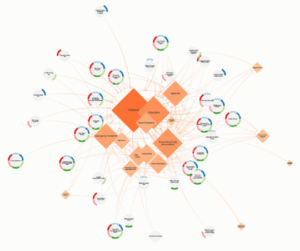After years of the Opioid Crisis, legal teams set about trying to hold pharmaceutical companies and manufacturers accountable. Local governments teamed across the U.S. to combine their damages into larger lawsuits. Now settlements are starting to be paid out and Colorado Attorney General’s office is asking those same local governments to work together to decide out how to use the much-needed funds. The San Luis Valley (or Region 18) saw some of the worst impacts in Colorado. With representation from 6 different counties, the Regional Settlement Governance Council reached out to The Civic Canopy for facilitation support. The task: help to form the council, set up working agreements, and develop a plan for the first two years of an 18-year settlement.
Early Challenges
Early on in facilitation, the Canopy heard an often-repeated story: people in the valley were great at collaborating until they weren’t. Necessity demanded that folks share resources. For example, public health departments regularly shared Narcan, a medication to treat Opioid overdoses, when they had more than they needed. At other times though, scarcity could get in the way by forcing folks with little resources to fight over even less.
Another challenge was that due to legal requirements. Only individuals who were elected officials or staff of local governments could be voting members of the council. This left out the expertise of people working for medical or nonprofit organizations serving folks with Opioid addiction and the people experiencing or recovering from addiction. Urban areas didn’t face this issue because there were experts available who could serve as non-voting members. But in rural areas, the same people who could provide the expertise would be the same folks likely to receive funding. This created a conflict of interest.
The Experiment
To address these challenges, the Canopy designed several guiderails :
- Adding an agreement that all decisions would be made by consensus between voting and non-voting members, but would go to a vote by voting members if consensus could not be reached
- Setting aside a portion of the dollars from the state to support folks with lived experience to participate in the process (i.e. computers, gift cards, meals)
- Ensuring each meeting had time for relationship building and a check out that would allow council members to reflect on how meetings could go better
In the end, there were 21 voting members and 30 non-voting members who participated, with about 40-50% in attendance for each council meeting. The Canopy worked with the council bi-weekly for nine months.
The Process
To begin, the council developed a network map of the regional services currently available to identify key gaps. Based on publicly available data and the regional services map, the council decided on a vision that all SLV residents are able to access opioid addiction awareness, education, treatment, prevention, and recovery resources. By 2024, the council will have identified resources and access gaps, strengthened, and sustained what’s working, and developed a strategy for addressing gaps.
decided on a vision that all SLV residents are able to access opioid addiction awareness, education, treatment, prevention, and recovery resources. By 2024, the council will have identified resources and access gaps, strengthened, and sustained what’s working, and developed a strategy for addressing gaps.
Over the course of the next two meetings, the Canopy facilitated a deliberation over each of the possible buckets of funding:
- Prevention
- Criminal Justice
- Treatment and Recovery
- Harm Reduction
Civic Canopy designed on-line meetings to assure wide participation. Canopy facilitated a process whereby the council discussed the benefits and drawbacks of focusing funding on each area. Based on the deliberation, each council member submitted their preferred funding allocation. The facilitator averaged submissions and provided them to the council. Based on the discussion, the council determined that funds would be better allocated in a few key areas than spread across all four primary service areas. Prevention & Education and Treatment & Recovery emerged as the top priorities for the group.
The Canopy, with guidance from the council, designed an evening focused on hearing from local people with lived experience. Council members and folks with lived experience broke bread together before breaking into small groups to share their stories. Then everyone came together utilizing a fishbowl technique which centers those with lived experience while council members listened to themes generated by the invited participants. The Canopy facilitated key questions and asked folks with lived experience to share:
- What might have helped prevent your use of opioids?
- Were you aware of any support programs during your addiction?
- Were there any limitations preventing you from receiving any programs?
- What resources were/are important to you in your recovery?
- What opportunities do you have for sober social activities? What would you like to see?
- The council is deciding how to spend around $300,000 every two years, for the next 18 years to address the opioid crisis (about 2.7 million in total). What else would you like the council to know?
Out of these conversations emerged three priorities: a prevention campaign, peer coaching network, and recovery housing (sober living units). In the end, the council was always able to reach consensus and did not have to resort to turning it over to voting members for a deciding vote. The voting members were legally required to take a final vote to approve the two-year plan and out of the 16 who voted, every single one of them voted “yes.”
Lessons Learned
Initially the Canopy worked to recruit folks with lived experience onto the council. This somewhat worked, but there are several barriers that made it hard. None of these folks had access to computers and may not have been used to joining Zoom meetings. Even with gift cards to compensate them for their time, making bi-weekly meetings was difficult as they navigated other more pressing needs (i.e. securing work, housing challenges). Having a trust-building in-person meeting was much more comfortable and ended up getting folks interested in becoming council members.
Consensus worked because the Canopy was able to move people out of their individual interests, “I need money for my program,” and into the collective interest, “The valley needs to fill a gap in recovery housing.” The shift happened because the council began at the big picture, setting an overall vision and giving time to discuss each area of funding. Then, the group narrowed in on priorities one step at a time, talking about the actual funding piece last. One drawback to this was that when groups were working on developing specific programs for funding, they tended to try to work together to create new programs instead of identifying current resources that could be further funded.
Next Steps
While the Canopy no longer facilitates the group, we’re able to provide some ongoing support and coaching through a different partnership with The Colorado Health Foundation that provides the Canopy time to work with nine communities throughout the state. The council has a steering committee, a funding committee, and a committee to oversee each of the funding areas. We can’t wait to see what they accomplish over the next 18 years.
Have you worked on similar challenges? What worked for you?


